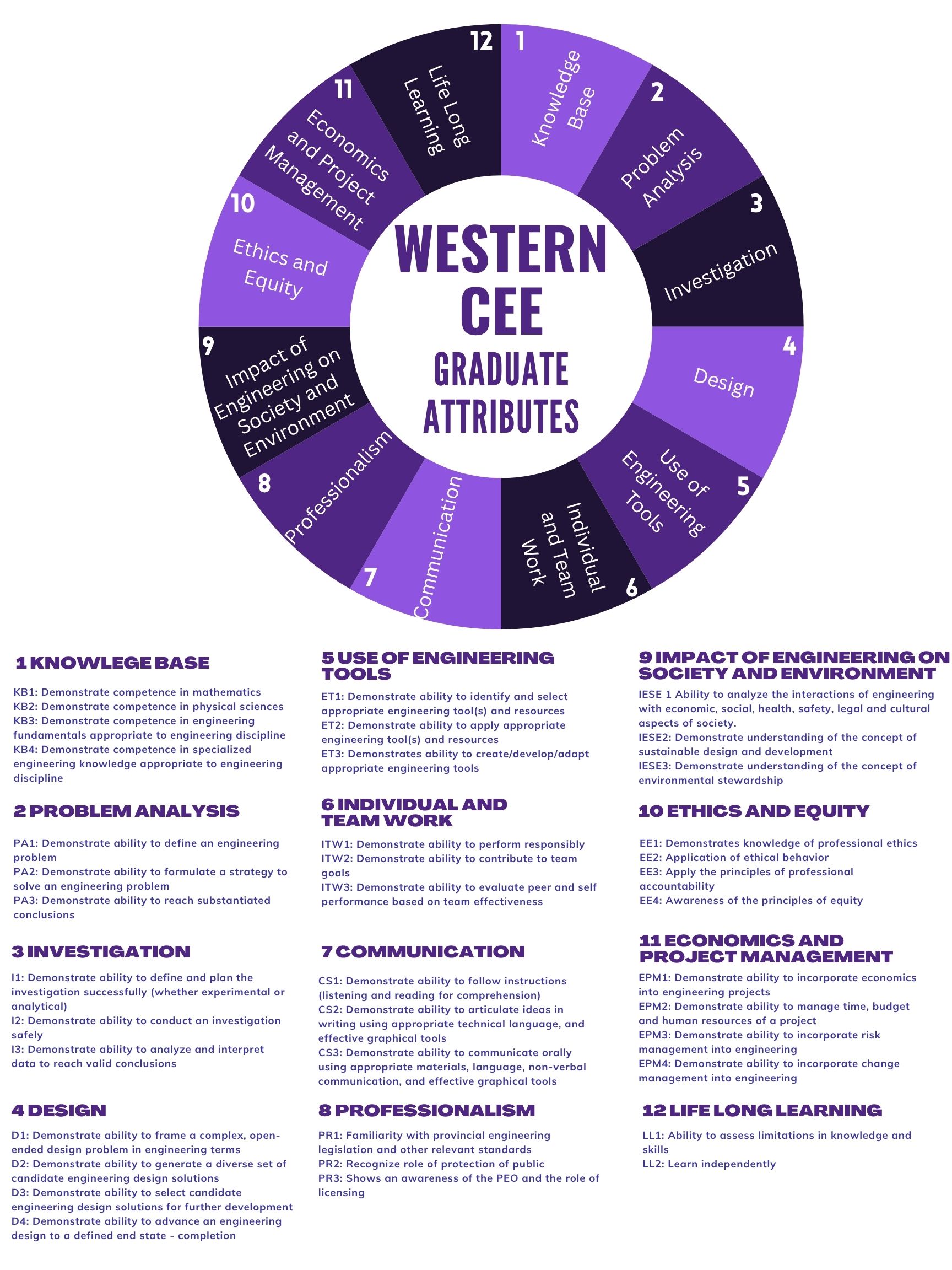Undergraduate Programs
Contact
Department of Civil and Environmental Engineering
Spencer Engineering Building,
Room 3005
Western University
Tel: 519-661-2139
Research program inquiries (MESc/PhD):
ceeresearchgrad@uwo.ca
Professional program inquiries (MEng):
ceeprofessionalgrad@uwo.ca
Undergraduate Inquiries:
civil@uwo.ca
Graduate Attributes
CEAB Accreditation
Engineers Canada, through the Canadian Engineering Accreditation Board (CEAB), is responsible for accrediting Canadian undergraduate engineering programs. The Civil and Environmental Engineering program at Western University is accredited by CEAB, meaning that graduates from this program meet the academic requirements to be licensed as a professional engineer in Canada.
CEAB Graduate Attributes
CEAB has defined 12 graduate attributes representing the abilities that all students in accredited engineering programs should demonstrate by the time that they graduate. For each graduate attribute, Western Engineering has created specific indicators of student competence. The Department of Civil and Environmental Engineering collects data on student performance with respect to these graduate attribute indicators as part of our work to continually improve our undergraduate program.
The 12 graduate attributes, their official CEAB definitions, and the accompanying indicators that the Department of Civil and Environmental Engineering uses to assess student competence in these areas are listed below.

1. A Knowledge Base for Engineering
Demonstrated competence in university level mathematics, natural sciences, engineering fundamentals, and specialized engineering knowledge appropriate to the program.
KB1: Demonstrate competence in mathematics
KB2: Demonstrate competence in physical sciences
KB3: Demonstrate competence in engineering fundamentals appropriate to engineering discipline
KB4: Demonstrate competence in specialized engineering knowledge appropriate to engineering discipline
2. Problem Analysis
An ability to use appropriate knowledge and skills to identify, formulate, analyze, and solve complex engineering problems in order to reach substantiated conclusions.
PA1: Demonstrate ability to define an engineering problem
PA2: Demonstrate ability to formulate a strategy to solve an engineering problem
PA3: Demonstrate ability to reach substantiated conclusions
3. Investigation
An ability to conduct investigations of complex problems by methods that include appropriate experiments, analysis and interpretation of data, and synthesis of information in order to reach valid conclusions.
I1: Demonstrate ability to define and plan the investigation successfully (whether experimental or analytical)
I2: Demonstrate ability to conduct an investigation safely
I3: Demonstrate ability to analyze and interpret data to reach valid conclusions
4. Design
An ability to design solutions for complex, open-ended engineering problems and to design systems, components or processes that meet specified needs with appropriate attention to health and safety risks, applicable standards, and economic, environmental, cultural and societal considerations.
D1: Demonstrate ability to frame a complex, open-ended design problem in engineering terms
D2: Demonstrate ability to generate a diverse set of candidate engineering design solutions
D3: Demonstrate ability to select candidate engineering design solutions for further development
D4: Demonstrate ability to advance an engineering design to a defined end state - completion
5. Use of Engineering Tools
An ability to create, select, apply, adapt, and extend appropriate techniques, resources, and modern engineering tools to a range of engineering activities, from simple to complex, with an understanding of the associated limitations.
ET1: Demonstrate ability to identify and select appropriate engineering tool(s) and resources
ET2: Demonstrate ability to apply appropriate engineering tool(s) and resources
ET3: Demonstrates ability to create/develop/adapt appropriate engineering tools
6. Individual and Team Work
An ability to work effectively as a member and leader in teams, preferably in a multi-disciplinary setting.
ITW1: Demonstrate ability to perform responsibly
ITW2: Demonstrate ability to contribute to team goals
ITW3: Demonstrate ability to evaluate peer and self performance based on team effectiveness
7. Communication Skills
An ability to communicate complex engineering concepts within the profession and with society at large. Such ability includes reading, writing, speaking and listening, and the ability to comprehend and write effective reports and design documentation, and to give and effectively respond to clear instructions.
CS1: Demonstrate ability to follow instructions (listening and reading for comprehension)
CS2: Demonstrate ability to articulate ideas in writing using appropriate technical language, and effective graphical tools
CS3: Demonstrate ability to communicate orally using appropriate materials, language, non-verbal communication, and effective graphical tools
8. Professionalism
An understanding of the roles and responsibilities of the professional engineer in society, especially the primary role of protection of the public and the public interest.
PR1: Familiarity with provincial engineering legislation and other relevant standards
PR2: Recognize role of protection of public
PR3: Shows an awareness of the PEO and the role of licensing
9. Impact of Engineering on Society and the Environment
An ability to analyze social and environmental aspects of engineering activities. Such ability includes an understanding of the interactions that engineering has with the economic, social, health, safety, legal, and cultural aspects of society, the uncertainties in the prediction of such interactions; and the concepts of sustainable design and development and environmental stewardship.
IESE1: Ability to analyze the interactions of engineering with economic, social, health, safety, legal and cultural aspects of society
IESE2: Demonstrate understanding of the concept of sustainable design and development
IESE3: Demonstrate understanding of the concept of environmental stewardship
10. Ethics and Equity
An ability to apply professional ethics, accountability, and equity.
EE1: Demonstrates knowledge of professional ethics
EE2: Application of ethical behavior
EE3: Apply the principles of professional accountability
EE4: Awareness of the principles of equity
11. Economics and Project Management
An ability to appropriately incorporate economics and business practices including project, risk, and change management into the practice of engineering and to understand their limitations.
EPM1: Demonstrate ability to incorporate economics into engineering projects
EPM2: Demonstrate ability to manage time, budget and human resources of a project
EPM3: Demonstrate ability to incorporate risk management into engineering
EPM4: Demonstrate ability to incorporate change management into engineering
12. Life-Long Learning
An ability to identify and to address their own educational needs in a changing world in ways sufficient to maintain their competence and to allow them to contribute to the advancement of knowledge.
LL1: Ability to assess limitations in knowledge and skills
LL2: Learn independently

